Military Robots
Military Robots

Military Robots by definition take Asimov's three laws of robotics and blasts them away in a brilliant flash of explosive destruction. These robots have three purposes: to monitor, to destroy property and to kill people.
The use of robots in warfare had its origins back in World War II. The Germans used a remote controlled military robot called Goliath, a track mine or demolition vehicle that with its 200 pounds of high-powered explosives could destroy tanks, buildings, bridges and kill multitudes of people. The Soviet Union produced a series of wireless remote-controlled unmanned robotic tanks called Teletanks in 1930s and the early 1940s, both of which saw some action in combat during the war.
Since then, several military robots have been developed by various armies, and many believe, including the Pentagon, that a future of automated weapons systems in modern warfare is imminent. The U.S. Military, for one, continues to invest heavily in the research and development of automated robotic weapon systems.
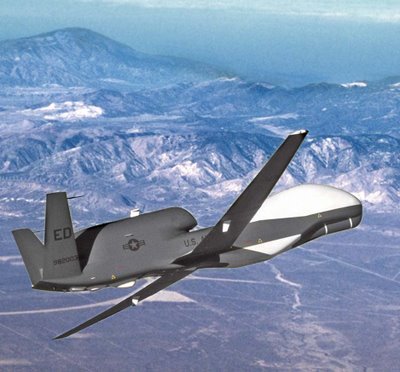
In the early 1980s, the Central Intelligence Agency (CIA) and the Pentagon began their experiments with reconnaissance drones, or unmanned aerial vehicles/ systems (UAV’s). These robots are aircrafts that fly without a human crew on board, deployed for reconnaissance as well as attack missions, or tasks that are considered too "dull, dirty, or dangerous" for manned aircraft.
First built in the early 1990s, the MQ-1 Predator today carries cameras and other modified and upgraded sensors that allow the drone to carry and fire two AGM-114 Hellfire missiles or other munitions. Since 1995, the Predator has seen combat over areas like Afghanistan, Pakistan, Bosnia, and Iraq. Compared to UAV’s, unmanned combat aerial vehicles (UCAV’s) are designed to attack targets with a great degree of autonomy.
Click HERE to read about DARPA's Military Robots
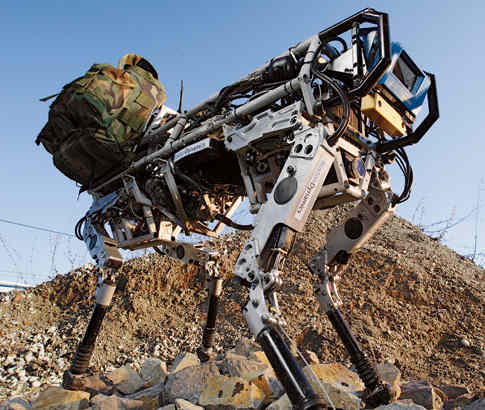
The Defense Advanced Research Projects Agency (DARPA), an agency of the United States Department of Defense responsible for the development of new technology to be used by the military also funds robotic companies like Boston Dynamics, which is developing BigDog a very different military robot, a 3 feet long, 2.5 feet tall, 240 pounds quadruped robot about the size of a small mule. This robot can traverse through snow, rain, ice, mud and other difficult terrain at 4 miles per hour, carry loads of up to 340 pounds, and climb a 35 degree incline, making it an ideal military convoy. More details on the BigDog will be found below.
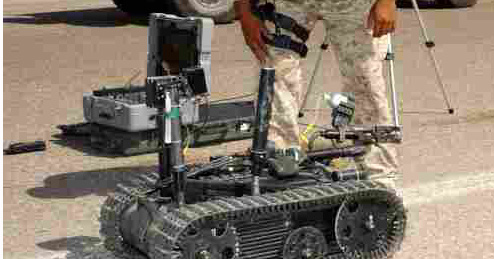
Other robots used in the field today are bomb-clearing robots, remote-controlled, wireless, lightweight bots “used for Improvised Explosive Device (IED) detection and identification,” according to the Pentagon. These IED’s are roadside bombs that have caused the deaths of 48.5% of the 3,270 U.S. troops killed in action in Iraq; these bomb-clearing robots are designed to find and disarm them. Even now, thousands of these tele-operated robots built with infrared and electro-optical cameras are scoping out caves, buildings and other potential enemy locations for IED’s and other useful information in Iraq and Afghanistan. These are missions that would be considered too dangerous for human troops.
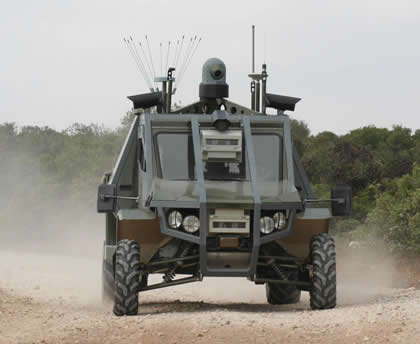
The U.S. army also uses unmanned ground vehicles (UGV), robotic systems that are capable of operating outdoors and over a wide variety of terrain in the place of humans. These autonomous robot tanks can gain information and adjust strategies based on their surroundings, travel from one point to another without human assistance and avoid harmful situations unless part of its design specifications. UGVs can either be tele-operated or autonomous, and some, like the Army's Multi-Utility Logistics Equipment (MULE) can be used for combat.
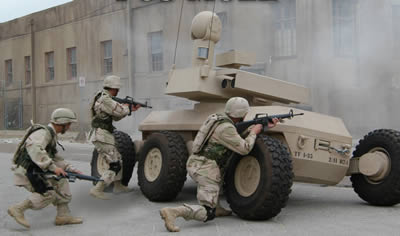
One of the several military robotic systems already in development, the 14-ft.-long, 6-wheeled MULE can cross barriers and navigate obstacles without human guidance. The robot is equipped with a range of navigational sensors and will eventually carry Javelin anti-tank missiles and M240 machine guns. In a few years, this robot will be able to navigate on its own, using onboard computers and sensors that beam back images of its surroundings. And like the UCAV’s, the MULE is designed to ultimately be able to fire deadly weapons on targets identified by its sensors.
Autonomous operation is one quality both anticipated and feared by many. It is a concern because allowing robots to identify targets and fire weapons on their own seems a little too risky, and images of the Terminator’s Hunter Killers
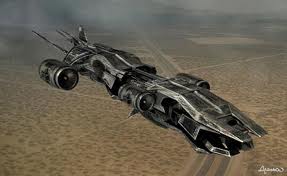
can’t help but flash into people’s minds. In 2009, technical and academic experts attended a conference that discussed the hypothetical possibility of robots and computer becoming self-sufficient and acquiring a level of autonomy equivalent to decision-making abilities, and whether this would pose any threats or hazards to public safety. Noted in the seminar were instances where robots have acquired some forms of autonomy, including being able to find power sources on their own and being able to choose targets to attack with weapons independently.
In a TIME article dated March 15, 2009, Daniel Goure, vice president of the Lexington Institute, a public-policy think tank says this on military robots, "It is tough enough for us to train human soldiers to distinguish between combatants and noncombatants on the battlefield. It is much more difficult to write software that does that." He adds, “What are the distinguishing characteristics between an enemy column and a parade of religious pilgrims going to a holy festival? If there is a bunch of people waving banners in trucks driving toward you, is that something you want a machine to decide?"
Ultimately, these military robots would still have to be controlled by humans, as the complexities of war is too much for even the toughest UAV or UGV to understand.
The BigDog Robot
Before we end off, there is a lot more to be said about the BigDog Robot (Not big dog robot, but "BigDog Robot).
I would think that everyone who’s seen the video of the giant, lumbering mechanical dog on Youtube has been more than a little spooked. Here is a large, robust machine built for war, and there are no human lives on board this future military robot. How futuristic is that? It moves uncannily (See our article on the "uncanny valley".) like a real animal too, powered by a hydraulic, actuation system that uses fluids and pressure to mechanize its legs. Standing more than 3 feet tall and weighing about 240 lbs, the headless dog ambles along, looking like it means business. And with the way its progress is going, it's really only a matter of time before the BigDog, or the LS3 (Legged Squad Support System), steps out on the battlefield.
Considered the alpha male of all the Boston Dynamics robots, the BigDog is a rough-terrain robot that walks, runs, climbs and carries heavy loads for its human masters. With four legs articulated like a real animal’s, the machine is equipped with features that absorb impact and recycle kinetic energy from one step to the next. This mechanism allows the BigDog to walk across virtually any type of terrain, while carrying loads of up to 340 lbs.
In tests, the BigDog is shown an ability to run at 4 mph, climb slopes angled up to 35 degrees, walk and climb across rubble, mud, snow and water. It has also set a world's record for legged vehicles, able to travel 12.8 miles without needing to stop or refuel. This is all controlled by BigDog's on-board computer, which handles its locomotion and the small servo motors that moves the robot’s legs.
This control system also navigates, provides the machine’s balance, and adapts according to conditions. The control system is equipped with a variety of sensors, including sensors for locomotion that include joint position, joint force, ground contact, ground load, a gyroscope, LIDAR and a stereo vision system. These basically tell the device where its joints are and what they are doing, such as whether the machine is in contact with the ground or not. Other sensors concentrate on the BigDog’s internal state, keeping its inner devices (hydraulic pressure, oil temperature, engine functions, battery charge, etc.) in check. BigDog's heightened sense can also survey its surroundings and recognize potential danger.
Apart from its fortitude, the Big Dog is extremely smart. Its programmed behaviors are some of the most advanced artificial intelligence and navigation systems ever developed. Big Dog can run or walk slowly along soldiers, lay down to be loaded or unloaded, and be aware of its surroundings the entire time. Only a direct and crucial hit can take the BigDog off its path, though it will never fall to the ground, no matter how hard it’s hit. This is due to its built-in laser gyroscope, which keeps BigDog on his metal paws, even when it slips, stumbles or is kicked over.
These dogs are not ready yet for actual battlefield action; its autonomy needs further improvement. Still, the US Army has high hopes for these bots. It is presently most effective way to carry all kinds of material, over any kind of terrain, reducing the weight that soldiers have on their bodies and freeing them to move faster and more efficiently. Just like pack mules, these robots spare the need to have to build roads over rugged landscapes. Robert Mandelbaum, a program manager in DARPA's Information Processing Techniques and Tactical Technology offices, says that “Some of the wars that we're engaged in now happen to have that kind of terrain."
The BigDog is created by Boston Dynamics, an engineering and robotics company “dedicated to the way things move.” Known for building highly advanced robots with remarkable behavior that utilizes mobility, agility, dexterity and speed, the company has already developed hopping and self-balancing robots that move like animals. The corporation is founded by former MIT Professor Dr. Marc Raibert, and is comprised of world-class development teams that take projects from initial concept to prototyping, to build-test-build engineering, to field testing and low-rate production. Some of its biggest clients include DARPA, the US Army, Navy and Marine Corps to Sony Corporation.
Building the complete military robot accordingly takes 30 months, at the cost $32 million. It is expected to debut in 2012. That means these legged robots will soon be fighting alongside humans, even replacing them entirely, a scenario long imagined by science fiction fans, from Terminator to the creators of Metal Gear. Now whether this is something to be thrilled or apprehensive about I can’t entirely say. All I know is these military robots are pretty cool to watch in action.